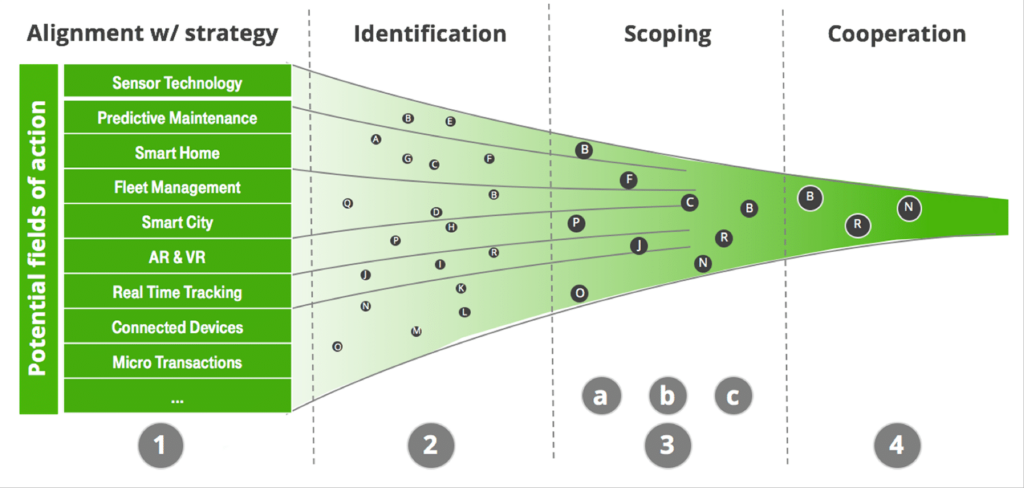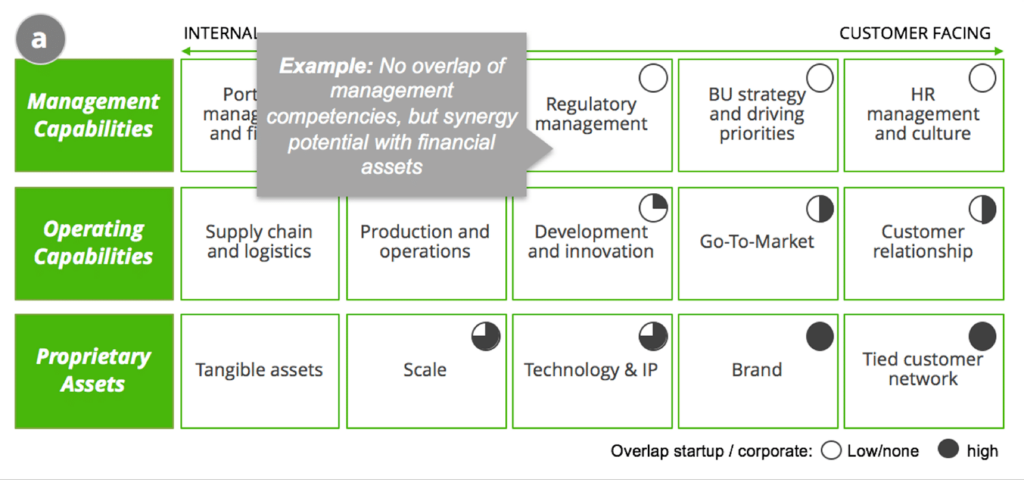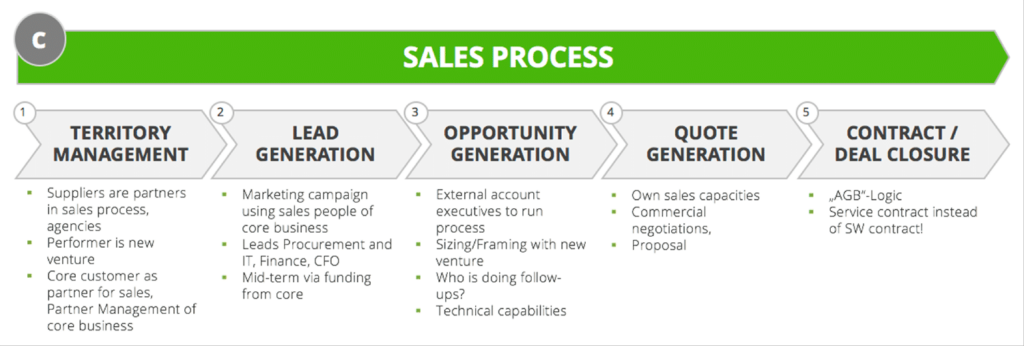Startup cooperation is the new oil (for corporate innovation)
In the past, corporates tried to diversify their portfolio by investing into or outright acquiring startups or building their own incubators. Often, these measures help with marketing, but are not unlikely to fail on delivering on larger objectives. Not only are startups usually not interested in pure capital investments, because they don’t want the corporate to steer their business, but also there is no realistic chance for a sustainable collaboration as long as the investments are not sufficiently in line with the corporate’s strategy.
Collaborating with startups should be more than just a marketing “shtick” – corporates even depend on startups to leverage technology know-how and a certain entrepreneurial approach that is not the corporate’s core business and way of working. E.g. a corporate trying to establish a substantial IoT business may need to cooperate with an already established startup, e.g. a predictive maintenance expert, to build its IoT business.
A well-known example for startup cooperations is the BMW Startup Garage. BMW routinely scouts startups with innovative technologies, products or services that can be integrated into BMW products and therefore add value to the corporate’s core business. Instead of investing into the startup and acquiring a share, BMW buys products and services from them and delivers a revenue stream to the startup.
As a second step, when the business relation is established, BMW may consider buying a stake in the company. Cooperation means building a balanced and sustainable partnership between the corporate and the startup.
But finding the right startups to cooperate is hard, because there are too many and not enough at the same time. We suggest to follow a funnel approach with four clearly structured steps to identify and evaluate the right startups that actually fit with the corporate’s strategic focus. This fit is what we consider the crucial part that needs far more thoughtfulness than corporates have historically shown.

Step 1: Align with strategy
Cooperation with startups isn’t done for cooperation’s sake. It needs to follow purpose and focus – and needs to be aligned with the strategic focus areas the corporate has defined – on a specific level. For example, if a corporate decides to move into the IoT space and has set focus on e.g. predictive maintenance, startups with expertise in sensor technology or advanced analytics are highly interesting for a cooperation and need to be channeled into the funnel. A corporate will likely have multiple of these focus areas in parallel, which is why the funnel will be sliced horizontally and needs to be managed in parallel.
Step 2: Identify the right startups
To identify potential cooperation partners, criteria should be defined to create a longlist of relevant startups, which should include the strength of their technology, their business model, their sales muscle and their management team. A topic-oriented overview of local and global market players needs to be developed and the funnel should be filled broadly and then narrowed down quickly. National and international startup databases should help find relevant companies. Leveraging personal startup and founder networks helps to quickly identify additional relevant companies. The longlist should be shortened to a list of about 10 startups to enter more specific discussions with.
Step 3: Scope the cooperation opportunity
To scope a potential cooperation model, we look at three things:
a) Overlap and complementarity of critical success factors of both businesses (e.g.: How much is owning tech IP a deciding factor?)
b) Synergy and support potentials of the business model canvas elements of both businesses (e.g.: How much do we use the same channels to address customers, maybe even competitively?)
c) Ability to align critical processes across the businesses (e.g.: How could and should the sales process be interlinked to deliver on scope synergies?)
a) Critical success factors
understanding the critical success factors of both businesses and how they play out with or against each other, is an important first step. We look at 15 different success factors, structured into categories management capabilities, operating capabilities and proprietary assets. In which ones is the startup strong and where can it be supported by the corporate’s expertise? What do we need to leverage (e.g. customer access, brand, IP) and where do we need to leave the startup alone (e.g. HR, regulations)?
We need to understand in detail how the building blocks of the two companies match and where they complement each other. This evaluation is the base to define which type of cooperation is the best option.

b) Synergy and support potential
In a second step, we typically work with the Excubate Corporate Startup Canvas to compare the two business models and identify synergy and conflict potential within each of the 12 canvas elements. Is the startup approach cannibalizing or complementing the corporate’s business model? How do value propositions compare, how do customer segments overlap, specifically? This results in a thorough analysis of similarities, synergies and conflicts that is highly valuable when designing the cooperation model with a startup or comparing options across multiple potential startup partners.

Step b) is obviously not fully free from overlaps with a), which we see as a benefit. We are challenging the discussion from a 2nd perspective (specifically looking at synergies and conflicts) and, thus, refine the view developed in a) to ensure a most thorough analysis.
c) Align critical processes
The third step is to identify options to link the core processes of both parties. For example, if the startup should be utilized as a “sales engine”, the different sales processes need to be analyzed in detail to fully describe how they can be aligned and in which step of the sales process the startup should be integrated. This analysis helps derive potential process dependencies or bottlenecks. Typically, the most important processes to consider are development, sales and customer service, and it’s key to focus on these and not boil the ocean by looking at all processes. The biggest levers are rarely internal processes like finance and HR, but sometimes it may even be those, e.g. when recruiting and building a team is critically important.

Step 4: Enter the cooperation and survive the honeymoon phase
When a potential cooperation model is identified and scoped out in detail, legal alignments should be made and contracts need to be set up. The objectives and deliverables for both sides should be clearly defined.
However, companies often end up creating an extensive legal paper and stretching this phase over an extended period, thus – in fact – often killing the cooperation before it started. Our above approach and analysis ensures a more trust-based approach that clearly outlines the win-win abilities of both parties in a very transparent and business-oriented way and makes extensive legal agreements less important. Both parties should trust in this cooperation and keep the contracting process lean, knowing the nuts and bolts of the cooperation upfront. We are convinced that if the first three steps followed a clear approach based on a thorough analysis, a fertile ground is created for a partnership on eye level with mutual goals and incentives. And wasting time and money on complex legal issues is minimized in the first place.
The “honeymoon phase” (i.e. the first six months of the cooperation) should be clearly defined and well managed to avoid that the cooperation fizzles out before it even started to gain traction. The onboarding process needs to be structured, a meeting and interaction countdown should be followed and roles be defined to start working the cooperation.
Building a strong startup cooperation muscle is getting more important for corporates to ensure their ability to innovate effectively and sustainably. Building this muscle is, however, far from trivial and can result in substantial loss of value, credibility and reputation if not done right. Building on experience and a thought-through methodology will help maximize the benefits of startup cooperations.
For more information, experience and an individual approach for your startup cooperation efforts, talk to Excubate: innovate@excubate.de



